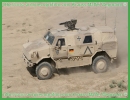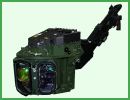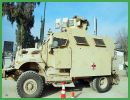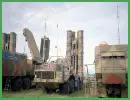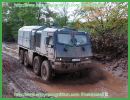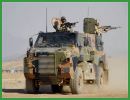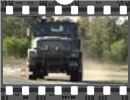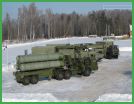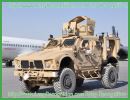| |
| |
Germany
(Krauss-Maffei Wegmann)  Back
Menu
Back
Menu
Norwegian
Army purchases Krauss-maffei Wegmann DINGO 2 wheeled armoured vehicle.
Munich,
29. October 2010 – The Norwegian Army has responded
to the increased threat of attacks by commissioning
Krauss-Maffei Wegmann (KMW) with the delivery of 20
DINGO 2 heavily armoured wheeled vehicles.
 Read
More
Read
More
29 October 2010
|
|
|
|
| |
United
States (Elbit Systems America)  Back
Menu
Back
Menu
Elbit
Systems U.S. Subsidiary Awarded $45.5 Million ID/IQ Contract for Night
Targeting System Upgrade for AH-1W Cobra Helicopters.
Haifa,
Israel, October 26, 2010 – Elbit Systems Ltd.
(NASDAQ and TASE: ESLT) announced today that its wholly-owned
U.S. subsidiary, Elbit Systems of America, LLC, was
awarded a $45.5 million Indefinite Delivery/Indefinite
Quantity (ID/IQ) contract from the Naval Surface Warfare
Center, Crane Division, Crane, Indiana for the supply
of the Night Targeting System Upgrade (NTSU) and associated
line items for the AH - 1W Cobra helicopters.
Work will be performed in Merrimack, New Hampshire
and is expected to be completed over the next five
years.
 Read
More
Read
More
26 October 2010
|
|
|
|
| |
United
States (Navistar)  Back
Menu
Back
Menu
Navistar
Defense launched both the International® MaxxPro® ambulance
kit and the MaxxPro Tractor at AUSA 2010.
WASHINGTON,
D.C., (October 25, 2010) Navistar Defense, LLC today
launched both the International® MaxxPro®
ambulance kit and the MaxxPro Tractor variant at the
Association of the United States Army (AUSA 2010)
Annual Meeting and Exposition.
 Read
More
Read
More
25 October 2010
|
|
|
|
| |
United
States (Jeep)  Back
Menu
Back
Menu
Recent
award of a contract for Jeep from the US Tank Automotive Command (TACOM)
to supply Jeep J8 Troop Carrier to Uruguayan military contingent in
Haiti.
Jeep®
Government and Military Sales announced on October
25, 2010 at the AUSA defense show in Washington, DC,
the award of a US Department of State contract under
the Global Peace Operations Initiative (GPOI) for
a fleet of J8 Troop Carriers for deployment with the
Uruguayan contingent to the UN Mission in Haiti.
 Read
More
Read
More
25 October 2010
|
|
|
|
| |
United
States (Elbit Systems of America)  Back
Menu
Back
Menu
Elbit
Systems of America to Showcase Solutions for Empowerment of Rapid Deployment
Forces at AUSA 2010.
FORT
WORTH, TX, October 25, 2010 – Elbit Systems
of America, LLC, a wholly owned subsidiary of Elbit
Systems Ltd. will present an array of cutting edge
solutions, designed to enhance the capabilities of
rapid deployment forces at the upcoming Association
of the United States Army Annual Meeting and Exposition
(AUSA), (booth #3205) set to take place in the Walter
E. Washington Convention Center, Washington DC from
October 25-27, 2010.
 Read
More
Read
More
25 October 2010
|
|
|
|
| |
Indonesia
 Back
Menu
Back
Menu
Indonesia
would like to develop its military collaboration with Russia.
Indonesia
would like to develop the military cooperation and
technique with Russia, said to RIA Novosti the Indonesian
minister of Defense Purnomo Yusgiantoro after the
handing-over of three Russian helicopters of Mi-35P
transport to the armed forces of the country.
 Read
More
Read
More
23 October 2010
|
|
|
|
| |
United
States (BAE Systems)  Back
Menu
Back
Menu
BAE Systems
Improving Soldier Protection Through U.S. Army Vehicle Armor Contract.
BAE
Systems has received an $11 million U.S. Army contract
to produce bar armor kits that protect soldiers in
ground vehicles from rocket-propelled grenade attacks.
The company will continue to produce L-ROD® bar
armor kits for the U.S. Army TACOM Life Cycle Management
Command's RG-31 Mine-Resistant Ambush-Protected vehicles.
 Read
More
Read
More
22 October 2010
|
|
|
|
| |
United
States (Force Protection)  Back
Menu
Back
Menu
Force Protection
Selects Manufacturing Base for Ocelot light protected vehicle in Australia.
Force
Protection Australasia, a Force Protection, Inc. group
company, today announced it had reached agreement
with the South Australian Government to manufacture
and support its Ocelot vehicle in Adelaide, if it
is successful in securing the contract to manufacture
up to 1,300 next-generation protected mobility vehicles
under the ‘Land 121 Phase 4’ program.
 Read
More
Read
More
22 October 2010
|
|
|
|
| |
Venezuela
 Back
Menu
Back
Menu
Russia to
deliver 35 main battle tanks T-72M1M to Venezuela.
Russia
will soon supply another shipment of tanks to Venezuela,
Prime Minister Vladimir Putin said at a meeting with
Venezuelan President Hugo Chavez on Friday. "Thirty-five
tanks will be delivered soon," he said. Putin
also said Venezuela is Russia's "reliable partner."
Chavez said the two states would speed up military
cooperation. Venezuela is building a plant to manufacture
Kalashnikov assault rifles. Since 2005, Venezuela
has bought over $4 billion worth of Russian weapons,
including warplanes, helicopters, and Kalashnikov
assault rifles. Earlier on Friday, Russia and Venezuela
signed an agreement on the construction of a nuclear
power station in the South American state. The agreement
was reached in April 2010 during Putin's visit to
Caracas. The presidents of Russia and Venezuela, Dmitry
Medvedev and Chavez, said on Friday bilateral ties
are strengthening. We are moving onto new agreements
on a wide range of projects," Medvedev said at
talks in Moscow. "We have a strategic partnership
- we are close friends." Medvedev also said Venezuela
acted "like a real friend" when it followed
Russia in recognizing the former Georgian republics
of South Ossetia and Abkhazia after Chavez's last
visit to Russia in September 2009. Chavez arrived
in Moscow on Thursday as part of an international
tour that also includes Belarus, Ukraine and Iran.
16 October 2010
|
|
|
|
| |
Russia
 Back
Menu
Back
Menu
Venezuela
could buy Russian air defense missile system S-300 PMU-1.
Russia's
S-300 air defense systems, which Moscow refused to
deliver to Iran following a new round of UN sanctions
against the Islamic Republic, could be sold to Venezuela
instead, a Russian arms trade expert said on Friday.
Russia signed a deal to deliver five battalions of
S-300PMU-1 air defense systems to Iran in 2007 but
banned the sale in September, saying the systems,
along with a number of other weapons, were covered
by the fourth round of sanctions imposed by the UN
Security Council against Iran over its nuclear program
in June. "Russia is looking for a buyer of five
battalions of S-300PMU-1 air defense systems ordered
by Iran, which are worth $800 million, and Venezuela
could become such a buyer," said Igor Korotchenko,
head of a Moscow-based think tank on the international
arms trade. Venezuelan President Hugo Chavez, who
is currently on a visit to Russia, earlier said his
country was interested in buying different types of
Russian-made air defense systems to create a multilayered
air defense network. Venezuela has already purchased
12 Tor-M1 air defense systems, a number of ZU-23-2
anti-aircraft guns and Igla-S portable short-range
air defense systems from Russia. The S-300PMU-1 (SA-20
Gargoyle) is an extended range version of S-300PMU
with a limited anti-ballistic missile capability.
Korotchenko said that if the S-300 deal with Venezuela
goes through, Caracas should pay cash for the missiles,
rather than take another loan from Russia. "The
S-300 is a very good product and Venezuela should
pay the full amount in cash, as the country's budget
has enough funds to cover the deal," Korotchenko
said. Moscow has already provided Caracas with several
loans to buy Russian-made weaponry, including a recent
$2.2-mln loan on the purchase of 92 T-72M1M tanks,
the Smerch multiple-launch rocket systems and other
military equipment.
16 October 2010
|
|
|
|
| |
Germany
(Rheinmetall)  Back
Menu
Back
Menu
Rheinmetall
and Timoney join forces in the military wheeled vehicle sector.
Rheinmetall
MAN Military Vehicles GmbH (RRMV) of Munich has entered
a farreaching agreement with Timoney Technology Ltd.
of Gibbstown, Ireland, to cooperate in the military
logistic and tactical vehicle sector. Under a license
agreement, Timoney Technology will develop and produce
independent suspension systems and power trains for
all new RMMV vehicle equipped with all-wheel drive
and independent suspension, including systems with
two, three or four axles. Based on the Timoney power
train technology in Rheinmetall’s Wisent armoured
transport vehicle, the result will be a new, highmobility
family of vehicles systematically designed to meet
the needs of the military.
 Read
More
Read
More
15 October 2010
|
|
|
|
| |
Greece
 Back
Menu
Back
Menu
Israeli and
Greek Air Force carry out joint exercises in the south of Greece.
Israeli
and Greek Air Force carry out joint exercises in the
south of Greece, information from the General staff
of the Greek air forces. Six Greek planes and three
helicopters, as eight Israeli combat helicopters take
part in these operations with the goal of rescue operations
in war time. The exercises began Monday October 11
to complete Thursday October 14. A delegation of the
Israeli ministry of Defence is currently in Athens
to sign a military cooperation program for 2011. The
military cooperation between Israel and Greece are
reinforced lately on bottom of increasing tension
between Israel and Turkey. The relations Turkey/Israel
were degraded following the boarding of the boats
for Gaza by Israeli soldiers who cost the life of
nine nationals Turkish people. Although Greece also
condemned this bloody boarding, since Greek citizens
were among the casualties of the boat Mavi Marmara,
at the end of a few months, these tensions reabsorbed.
Greece and Israel underline however that their military
cooperation is not directed against Turkey and any
another country.
14 October 2010
|
|
|
|
| |
Russia
 Back
Menu
Back
Menu
Israel Aerospace
Industries deliver UAV components to Russia.
Israel
Aerospace Industries said on Wednesday it has signed
a contract with the Russian defense firm Oboronprom
on the delivery of assembly components and servicing
for aerial drones. "The deal will begin to be
implemented during 2011," the company said in
a statement posted on its website. The contract was
signed in the presence of the Russian Minister of
Industry and Trade Viktor Khristenko. The financial
details of the deal have not been disclosed, but Israeli
media earlier speculated that the three-year contract
could be worth $400 million. Russia has already signed
two UAV contracts with Israel. Under the first contract,
signed in April 2009, Israel delivered two Bird Eye
400 systems (worth $4 million), eight I View MK150
tactical UAVs ($37 million) and two Searcher Mk II
multi-mission UAVs ($12 million). The second contract
was for the purchase of 36 UAVs, worth a total of
$100 million, to be delivered later this year. Russia
and Israel have also been negotiating the establishment
of a joint $300-million venture to produce UAVs. Israel
said in September it may tear up much of the aerial
drone deals it signed with Russia due to anger over
Moscow's decision to supply Yakhont naval missiles
to Syria.
13 October 2010
|
|
|
|
| |
Inde
 Back
Menu
Back
Menu
Russia and
India will conduct joint antiterrorism exercises INDRA 2010 on Indian
territory.
Russia
and India will conduct joint antiterrorism exercises
on Indian territory on October 15-24, the Russian
Defense Ministry said on Wednesday. Russia is sending
more than 200 troops from its 34th mountain brigade,
based in the North Caucasus, to join the Indian troops
in the INDRA 2010 drills. "During the upcoming
exercise, the Russian and Indian military personnel
will form a joint task force, and plan and carry out
a series of mock antiterrorism missions in the mountains,"
the ministry said in a statement. The Russian troops
will be equipped with lightweight Permyachka Infantry
Suits, which protect at least 80 percent of the body
surface from small-caliber bullets and low-speed shrapnel.
The Russian and Indian military have been conducting
joint INDRA exercises, including biannual antiterrorism
drills, since 2003.
13 October 2010
|
|
|
|
| |
Australia
 Back
Menu
Back
Menu
Australian
minister of Defence inspects the Thales Bushmaster vehicles used by
Australian soldiers in Afghanistan.
Minister
for Defence Materiel Jason Clare today visited Thales
in Bendigo to inspect the Bushmaster vehicles used
by Australian soldiers in Afghanistan. Bushmasters
are made in Bendigo and are used to transport troops
in the field. Mr Clare was joined by the Member for
Bendigo Steve Gibbons, the Chief Executive Officer
of Thales Australia Chris Jenkins and Brigadier David
Shields. There are already 584 Bushmaster vehicles
in service. A further 153 vehicles are expected to
be delivered by March 2012. Mr Clare said “These
vehicles are saving the lives of Australian soldiers
in Afghanistan”. "When our troops move
around in Afghanistan, they do it in Bushmasters made
here in Bendigo. "They have been hit hard by
IEDs (improvised explosive devices) and have done
an incredible job protecting the lives of the Australian
soldiers inside.” Thales has also sold the Bushmaster
vehicle to the British Army and the Netherlands Army.
Mr Clare said the Defence Export Unit was working
closely with Thales to pursue more overseas opportunities
for the Bushmaster.
12 October 2010
|
|
|
|
| |
Israel
 Back
Menu
Back
Menu
Merkava Mark
4 with “Trophy” Active Tank Defense System to Be Used in
Joint Combat Exercise Demonstration for First Time.
A
demonstration of the Joint Combat Exercise will take
place tomorrow, Tuesday, October 12th, at the IDF
base of Shizafon. The event will be in the presence
of the IDF Chief of the General Staff, Lt. Gen. Gabi
Ashkenazi, Deputy Chief of the General Staff, Maj.
Gen. Benny Gantz, and the Chief of the Ground Forces,
Maj. Gen. Sami Turgeman. Senior ground forces officers
will also participate in the joint combat demonstration.
The Joint Combat Exercise summarizes the training
of ground force officer cadets and its objective is
to implement the collaboration between the different
branches and corps. Tomorrow’s demonstration
will display the ground forces’ abilities, in
which Officers’ Training School cadets from
the infantry, engineering, armored, and artillery
corps perform drills that combine various diverse
combat techniques. These include urban warfare, advancing
through complex obstacles, using artillery support,
and employing invasion techniques, along with aerial
support of the Israel Air Force, including medical
evacuations and aerial re-supplies. This demonstration
will commence the Joint Combat Exercise that continues
for ten days. The demonstration includes live fire
and presents the interoperability of the ground and
air forces by displaying a combined battalion fighting
in different operational settings. This will be the
first joint combat demonstration in which the Merkava
Tank Mark 4 and the “Trophy” (Meil Ruach)
active tank defense system will be presented. The
Meil Ruach system is a new defense system against
anti-tank missiles and will be demonstrated by firing
a dummy missile at the tank.
11 October 2010
|
|
|
|
| |
United
States (Oshksoh)  Back
Menu
Back
Menu
Oshkosh Defense
Equips U.S. Army with TerraMax Vehicle for Autonomous Logistics Missions.
Oshkosh
Defense, a division of Oshkosh Corporation, will showcase
a U.S. Army vehicle equipped with Oshkosh TerraMax
unmanned ground vehicle (UGV) technology at the Association
of the United States Army (AUSA) Annual Meeting and
Exposition at the Washington Convention Center October
25 – 27. The TerraMax technology delivers improved
troop protection by reducing human exposure to battlefield
threats, such as improvised explosive devices (IED),
and increasing situational awareness while the vehicle
is on the move. “Oshkosh is committed to bringing
this life-saving technology to the field,” said
Gary Schmiedel, Oshkosh Corporation senior vice president
of Defense Engineering and Technology. “Our
TerraMax technology is designed as a kit that can
be integrated in new vehicles as they are produced
or retrofitted into the government’s existing
vehicle fleets.” The Oshkosh Family of Medium
Tactical Vehicles (FMTV) Load Handling System (LHS)
variant is equipped with the company’s unmanned
technology for autonomous logistics missions. The
TerraMax fully-autonomous navigation kit has been
demonstrated on the Marine Corps’ Medium Tactical
Vehicle Replacement (MTVR) 4x4 and 6x6 vehicles, as
well as the Army’s Palletized Load System (PLS)
vehicle. “The TerraMax fully autonomous system
provides flexibility to the Warfighter,” added
Schmiedel. “It is integrated so each vehicle
can still be manually driven with the press of a button.
The technology is capable of fully autonomous missions
supervised from an escort vehicle at a safe standoff,
or operation in leader-follower mode, depending on
the mission and situation.” Oshkosh Defense
has been awarded a five-year FMTV contract for the
production of an estimated 23,000 trucks and trailers,
as well as support services and training through fiscal
2014. The FMTV is a series of 17 models with payload
capacities ranging from 2.5-tons to 10-tons. The Oshkosh
FMTV LHS with TerraMax UGV kit will be on display
Oct. 25-27, 2010, in booth 2639 at the Washington
Convention Center at the AUSA Annual Meeting and Exposition.
11 October 2010
|
|
|
|
| |
CCG
and Jordan  Back
Menu
Back
Menu
In 2011,
the Gulf countries will buy for $68 billion of armaments.
In
2011, the Member States of Cooperation Council of
Gulf (CCG), as well as Jordan, will spend at least
68 billion dollars in purchases of armaments, announced
Friday the newspaper GULF News while referring to
a report published by the experts of the Frost&Sullivan
group. The Cooperation Council of Gulf (CCG) is composed
of six States: Saudi Arabia, United Arab Emirates,
Kuwait, Qatar, Bahrain and Oman. “This figure
(68 billion dollars) will be increased to 80 billion
dollars in 2015, and it is awaited that the military
expenditure of all the countries of the Middle East
will exceed in this same year the figure of 100 billion
dollars, the large one of the expenditure belonging
to Saudi Arabia”, reads one in the report. According
to the experts of Frost&Sullivan, Saudi Arabia
spent in 2009 41,2 billion dollars in purchases of
armaments. Currently, the United States and Saudi
Arabia prepare the signing of a contract of 60 billion
dollars, bearing on the delivery in Riyadh of tens
of planes and helicopters, including 84 fighting aircrafts
F-15, 70 Apache helicopters, 72 helicopters Black
hawk and 36 helicopters Little bird. “In the
Middle East, Saudi Arabia, the United Arab Emirates
and Kuwait are the champions in the field of the purchases
of armaments. During years 2000-2009 the Member States
of the CCG and Jordan spent nearly 493 billion dollars
in purchases armaments”, concludes the report
from the experts.
10 October 2010
|
|
 |
Gulf
Cooperation Council logo
picture |
|
|
| |
Iran
 Back
Menu
Back
Menu
Iran is
resolved to boost its defensive power
against possible enemy attack.
Senior Iranian commander said Iran is resolved to
boost its defensive power in a bid to bolster the
country's deterrent capabilities against a possible
enemy attack. "The more progress we make in defense,
naturally the more deterrence we will have against
the enemy," Deputy Head of the Joint Chief of
Staff of the Iranian Armed Forces Brigadier General
Massoud Jazayeri said Saturday. "The Islamic
Republic of Iran's defense doctrine tries to provide
broad defense for the country's ground, air and sea
borders," he noted. He stated that a higher deterrent
power will increase enemies' losses even in case of
limited wars. Jazayeri further warned about the severe
consequences of any new conflict in the region, and
stated, "Of course, we assume that if a new war
erupts in the region, it will not be a limited war
and will leave many negative consequences." "Accordingly,
any move towards deterrence is a positive step,"
the commander noted. Jazayeri further underscored
that Iran's deterrent capability covers an area far
beyond the region. In August 2010, Supreme Leader
of the Islamic Revolution Ayatollah Seyed Ali Khamenei
warned the US against the grave consequences of any
military aggression against Iran, stressing that Tehran's
response to such an attack will not be limited to
Washington's interests in the region. "The Americans'
resorting to military attack is a remote possibility,
but if so, Iranians' counter-attack will not be merely
regional, but covering a vaster scene," Ayatollah
Khamenei said at the time.
10 October 2010
|
|
|
|
| |
Turkey
 Back
Menu
Back
Menu
Iran and
Turkey to boost counter-terrorism cooperation.
Turkish
Interior Minister Besir Atalay is slated to visit
Tehran within the next few weeks to confer with Iranian
officials on increasing cooperation between the two
countries in their fight against terrorism. Atalay
told reporters after a meeting with his Syrian counterpart
in the port city of Latakia that neighboring countries
could always undertake joint security operations,
adding that Turkey and Syria not only cooperated against
terrorism but also against illicit drug and human
trafficking. "There might be joint operations
in several fields. Syria has recently staged sensitive
operations. They were not joint operations but we
were informed about them. There might be mutual requests
on security issues," Atalay said. Iran and Turkey
have in recent years boosted their cooperation in
all the various fields of economy, security, trade,
education, energy and culture. The two sides have
exchanged several politico-economic delegations during
the last few months.
10 October 2010
|
|
|
|
| |
Germany
(Krauss-Maffei)  Back
Menu
Back
Menu
Krauss-Maffei
Wegmann delivers 20 upgraded LEOPARD 2A4 main battle tanks to Canada.
Krauss-Maffei
Wegmann (KMW) has handed over the first of 20 LEOPARD
2 A4M CAN modernised battle tanks to the Canadian
armed forces yesterday, October 7th 2010. The roll-out
took place in the presence of the Canadian military
representative, Vice Admiral Denis Rouleau, and the
General der Panzertruppen, Brigadier General Klaus
Feldmann, and numerous other representatives of the
Canadian and German army on training area at Bergen
near Hannover (Germany). The next deployment location
for the Canadian LEOPARDS will be Afghanistan.
 Read
More
Read
More
08 October 2010
|
|
|
|
| |
Germany
(Rheinmetall)  Back
Menu
Back
Menu
Leopard 2A4
main battle tank from Rheinmetall for the first time in Africa.
Marking
the African debut of the Leopard 2A4, Rheinmetall
Defence of Germany took advantage of Africa Aerospace
& Defence 2010 (AAD) in Cape Town to put the world’s
finest main battle tank through its paces. Daily live
presentations on a special test track proved to be
a major draw, with the Leopard 2A4’s excellent
mobility in rough terrain clearly impressing the crowd.
Rheinmetall has been developing and producing armoured
vehicles for over forty years. The Leopard 2 continues
to set the global standard for modern main battle
tanks, with more than 3,600 in existence, now in service
with 16 nations. Although Rheinmetall is not the main
contractor for the Leopard 2 MBT, the company has
nevertheless played an integral role in its development
and production. Moreover, out of a total 2,125 Leopard
2A4 tanks produced, 977 were manufactured entirely
by Rheinmetall in Kiel for the German and Dutch armed
forces.
 Read
More
Read
More
08 October 2010
|
|
|
|
| |
India
 Back
Menu
Back
Menu
Russian Defense
Minister on visit to India to discuss about bilateral military cooperation.
Russian
Defense Minister Anatoly Serdyukov, on a two-day visit
to India since Wednesday, will discuss bilateral military
cooperation on Thursday, his spokeswoman said. "The
Russian defense minister will attend the tenth meeting
of the Russian-Indian intergovernmental commission on
military and technical cooperation," Lt. Col. Irina
Kovalchuk told journalists. She said the sides will
sum up defense activities in 2009 and outline priority
tasks to further develop military cooperation. "After
the meeting the sides are to sign the final protocol
defining the basic directions of bilateral military
and technical cooperation and specifying ways to implement
the current projects," Kovalchuk said. Serdyukov
will hold talks with his Indian counterpart Arackaparambil
Kurian Antony. According to Kovalchuk, the key issues
for the intergovernmental commission's consideration
are the retrofit by Russia of the Admiral Gorshkov aircraft
carrier for India's Navy and licensed manufacturing
of Sukhoi Su-30MKI Flanker-H and T-90S tanks in India.
07 October 2010 |
|
|
|
| |
Iran
 Back
Menu
Back
Menu
Iranian President
to Offer Weapons to Lebanese Army.
Iranian
President Mahmoud Ahmadinejad plans to offer Lebanon
weapons, oil excavation assistance and construction
aid during his upcoming visit to the country Oct. 13-14.
During his trip he plans to meet with senior Hezbollah
officials and make a public speech about the Israeli-Palestinian
peace talks. Ahmadinejad also is expected to recognize
Lebanon as an official Iranian base in the Middle East
and that Hezbollah-controlled southern Lebanon is “Iran's
border with Israel.” Iran funnels weapons and
funding to its proxy within Lebanon, Hezbollah. Numerous
experts suggest that Iran-backed Hezbollah is so entrenched
in Lebanon's political and military culture that it
can influence military operations and commands. On Aug.
4, a skirmish on the Israeli-Lebanese border began when
a member of the Lebanese Army shot and killed an Israeli
officer. A UN report found Lebanon responsible for the
incident. After the clash, the U.S. Congress deliberated
halting providing weapons to the Lebanese Army. Lebanon
was going to reject the U.S. weapons if they came with
orders forbidding their use on Israel. "Iran stepped
in at this moment and is now expected to offer arms
to Lebanese President Michael Suleiman in the upcoming
visit," Dr. Ely Karmon, a senior researcher at
the International Institute for Counter-Terrorism at
the Israel-based Interdisciplinary Center told The Israel
Project on Oct. 6. American officials voiced disapproval
over Ahmadinejad's scheduled trip to Lebanon.
06 October 2010 |
|
|
|
| |
Algeria
 Back
Menu
Back
Menu
Intensification
of collaboration in the military field enters Algeria and Russia.
Russia
and Algeria intend to intensify the co-operation in
the field of the armaments, announced Russian President
Dmitri Medvedev at the time of a press conference at
the conclusion of negotiations in Algiers with the President
of Algeria, Abdelaziz Bouteflika. According to the Russian
president, any military technical co-operation requires
necessarily confidence, and the co-operation which currently
binds Russia and Algeria is precisely founded on confidence.
“This co-operation continues since tens of years
and is characterized by substantial amounts. We are
satisfied with his development”, declared the
Head of the Russian State.
06 October 2010 |
|
|
|
| |
Pakistan
 Back
Menu
Back
Menu
More NATO
trucks attacked in Pakistan by Pakistani Taliban's.
More
NATO lorries have gone up in smoke in Pakistan, after
the fourth attack on a supply convoy in just six days.
Militants attacked dozens of vehicles parked up at a
hotel on the outskirts of the south-western city of
Quetta. The lorries were heading for another crossing
into Afghanistan, after Islamabad closed the Khyber
Pass route last week following a NATO border incursion.
Firefighters worked for hours to get the blaze under
control. One man, thought to be a truck driver, was
killed in the attack. It is unclear who was behind it.
The Pakistani Taliban have said they carried out similar
attacks, including one on Monday in which four people
died.
06 October 2010 |
|
 |
| NATO
trucks attacked in Pakistan by Pakistani Taliban's.
Video source Euronews |
|
|
| |
United
States (Navistar)  Back
Menu
Back
Menu
Navistar
Defence wins first navy contract for 38 International® 5000-MV heavy
truck tractors.
Navistar
Defense, LLC today announced that it has received an
award for $18.9 million from the Naval Facilities Engineering
Command (NAVFAC) for 38 International® 5000-MV heavy
truck tractors (HTTs). The company’s first contract
with the U.S. Navy includes three option periods for
additional vehicle orders. A proven heavy-haul tractor,
the 5000-MV HTT unit will support Navy Seabee transportation
needs. The vehicles incorporate a variety of armoring
solutions derived from the International® MaxxPro®
Mine Resistant Ambush Protected (MRAP) vehicle. Units
include a manual 18-speed transmission and a MaxxForce®
D 13L engine. “We are very appreciative of the
Navy’s decision to select our HTT offering,”
said Archie Massicotte, president, Navistar Defense.
“The Seabees have a long history of building new
infrastructures half way around the world and we are
proud to be a part of that tradition going forward.”
Similar 5000-MV HTT variants were used by the U.S. Army
during two Persian Gulf Wars to transport tanks across
the Northern Saudi Arabian Desert. Nearly 600 HTT units
are currently in service with KBR and the Iraqi Ministry
of Defense to support security and rebuilding efforts.
Production of HTT vehicles will begin in early 2012.
Spare parts and training services are included in the
contract.
06 October 2010 |
|
|
|
| |
Netherlands
 Back
Menu
Back
Menu
First Firing
of Surface-Launch AMRAAM Missile for the Dutch Army.
The
Dutch army is introducing the Surface-Launched Amraam
missile for its air-defense units, and recently carried
out its first firing in Norway.(Dutch MoD photo)The
Dutch army’s air-defense artillery has carried
out the first ground launch of an Amraam (Advanced Medium-Range
Air-to-Air Missile) missile on the very tip of Norway’s
Andøya peninsula. The army’s air-defense
component has been working towards this launch since
the introduction of the missile in early 2009. The purpose
of this first live-firing exercise was to test the integration
of the weapon in the Army Ground Based Air Defense System.
This system is intended to defend against aerial threats
at low and medium altitudes. The Amraam covers the medium-high
altitude layers at ranges of up to 75 km, while the
shoulder-launched Stinger missile covers very low altitudes.
The Amraam has its own radar and can be fired autonomously
to independently track its target. After months of procedure
training and exercises, this week saw the first real
firing of the ground-launched Amraam missile, which
is almost 4 meters long and which reaches speeds in
the order of 5,000 km/hour. Its firing is only authorized
in Norway and the United States. Besides the weapons
section, the unit practiced the entire engagement sequence
as a whole. The radar generated an image of the air
space up to the moment of firing, which was carried
out by simply pushing a button. The missile hit its
target well beyond visual range. More than 100 troops
and logistic personnel were involved in the launch.
05 October 2010 |
|
|
|
| |
France
(HGH)  Back
Menu
Back
Menu
HGH French
Company Vigiscan infrared panoramic camera, the ultimate solution for
long range surveillance.
Throughout
the world, security issues are becoming increasingly
important due to the current political and economical
situation. Formerly reserved to the Defence sector,
surveillance technologies for site monitoring are now
required in many sectors. To this aim, very often a
multitude of sensors using different technologies are
installed, i.e. radar, light intensification cameras,
CCTV, infrared barriers, lasers, IR cameras. These are
spread around or within the monitored area in order
to secure it.
 Read
More
Read
More
05 October 2010 |
|
|
|
| |
Israel
(Elbit Systems)  Back
Menu
Back
Menu
Elbit Systems
Awarded Asian Tank Upgrade Contract Valued at Approximately $56 Million.
Elbit
Systems Ltd. announced today that it was awarded an
approximately $56 million tank upgrade contract from
a customer in Asia. Under the contract, the tank upgrade
project will include the installation of advanced battle
management systems, as well as cutting edge observation
and surveillance systems. The project will be completed
within two years. Joseph Ackerman, Elbit Systems' President
and CEO, noted: "Our selection for this upgrade
project, following previous projects we have carried
out for this customer, attests to the high level of
satisfaction with our systems and performance."
Ackerman added that both Elbit Systems subsidiaries
Elbit Systems Land & C4I - Tadiran and Elbit Systems
Electro-optics - Elop will take part in the project,
and the successful synergy among Elbit Systems' different
units enables the Company to offer its customers cutting
edge, end-to-end solutions.
03 October 2010 |
|
 |
| Elbit
Systems Israel Israeli Defense Industry |
|
|
| |
Afghanistan
 Back
Menu
Back
Menu
Manpower
of the Afghan army could reach 240.000 soldiers in the next years.
Currently,
manpower of the Afghan army is around 140.000 soldiers,
announced this September 03, 2010, the spokesperson
of the Afghan ministry of Defence, the general Zahir
Azimi during a press conference in Kabul. According
to him, about June 2011, the Afghan army will count
171.600 soldiers to carry later on its manpower to 240.000
people. As for the police force, the number of police
officers will be increased of 109.000 current to 240.000.
In this way, the national security forces will count
400.000 personnel, specified the general. By evoking
the situation in the province of Kunduz (northern of
Afghanistan), the general declared that “we will
not allow to transform the northern province of Kunduz
into a centre of terrorist activity in Afghanistan”.
According to the governor of Kunduz, the very calm province
formerly, is transforming itself into a centre of activity
of the Taliban’s and terrorists coming from Chechnya,
of Uzbekistan and Pakistan, more than 40% of the territory
of the province being controlled by the Taliban’s.
The spokesperson of the International Security Assistance
Force (ISAF) in Afghanistan Josef Blotz, present at
the press conference, indicated that there were 45.000
foreign soldiers making their service in the north of
Afghanistan.
03 October 2010 |
|
|
|
| |
Iran
 Back
Menu
Back
Menu
Iran Unveils
Several Electronic, Optic, Radar Systems.
The
Iranian Defense Ministry on October 03, 2010 unveiled
over a dozen electronic, optic and radar systems on
the occasion of the Sacred Defense Week, commemorating
Iranian sacrifices during the 8 years of the Iraqi
imposed war on Iran in 1980s. During the ceremony
attended by Iranian Defense Minister Brigadier General
Ahmad Vahidi, 20 electronic, optic and radar projects
were unveiled in Shiraz Electronic Industries (SA
Shiraz) a subsidiary of the Defense Ministry's Iran
Electronic Industries (SA Iran). "Thanks to the
hard efforts made by innovative and diligent experts
of the defense ministry's electronic industries in
SA Shiraz, we managed to hand 10 systems (to the Armed
Forces), inaugurate production lines of 7 other systems
and unveil 3 newly made electronic, optic and radar
systems," Vahidi said at the ceremony. The minister
added that the systems have been developed for different
fields of action, including electronic warfare, radar
technologies, guiding and navigation and smart bombs
and weapons technologies. Vahidi noted that the projects
also include electronic technologies for controlling
vessels and sub-surface vessels, including different
types of coastal radars, airport approach radar, long-rang
air defense radar, Ionic systems, heat-sensing and
tracing cameras, electronic warfare system, detection
systems, communication and radar surveillance and
eavesdropping and electronic smart cards and devices.
03 October 2010
|
|
 |
| Iran
unveils several electronic, optic and radar system for
the Iranian army |
|
|
| |
France
(Thales)  Back
Menu
Back
Menu
Thales reveals
PROJECT CYTOON – another milestone in its association with the
South African National Defence Force.
Thales
Defence Systems, the Thales system integrator in South
Africa, is delivering an integrated tactical intelligence
system for the South African National Defence Force
(SANDF) referred to as PROJECT CYTOON. The system, designed
to equip an intelligence, Surveillance, Target Acquisition
and Reconnaissance (ISTAR) tactical unit, has been designed
to address various requirements such as tactical intelligence,
homeland security and boarder surveillance. Thales provides
various sensors (such as radar and optical sensors),
a specifically developed software for multi-sensor exploitation,
field deployable infrastructure and dedicated tactical
communications. Thales has teamed up with various local
and international partners whose products have also
been integrated. The resulting system has been designed
to address the exclusive intelligence requirements of
the SANDF, and in doing so established a unique state
of the art intelligence gathering system. PROJECT CYTOON,
a major reference of the Thales-wide Comm@nder Intel
know-how, has been completed and is ready for commissioning
into the SANDF. Operational field tests are being conducted
at this moment prior to system delivery to SANDF. It
will be complemented soon with the delivery of a training
subsystem to support the specific training needs of
the South African Army, Intelligence Formation.
03 October 2010 |
|
 |
| France
French Defense Industry Thales |
|
|
| |
Belarus
 Back
Menu
Back
Menu
Belarus wishes
to acquire the Russian ground-to-air defense missile system S-400.
Belarus
wishes to acquire the new Russian ground-to-air missiles
system S-400 Triumph, announced this 01 October 2010
to the journalists, the vice-president of State Belarus
Committee of military-industrialist Alexandre Soloninko.
Minsk plans to buy in Moscow anti-missile defence systems
S-400, indicated the person in charge before adding
that the Russian ground-to-air missiles S-400 is one
of the best system in the world. However, the export
of S-400 is not officially with the day order for Russia.
The Russian vice-minister of Industry and Trade Louri
Borissov had indicated before that as long as the Russian
Armed forces would not be sufficiently equipped out
of missiles of the S-400 type, it would be premature
to consider the export of the latter. “However
that appears in our projects. The departments (Russian,
note) of export of armaments receive already orders”,
it added. At the end of February 2008, the Belarus Minister
of Defense, Leonid Maltsev, announced that within the
framework of the modernization program of the Belarus
army, Minsk planned to get of S-400. The Russian agency
of armaments export, Rosoboronexport, declared in May
2009 that the purchase of S-400 system is a decision
from an intergovernmental commission Russo-Belorussia
and that this decision was not made yet.
01 October 2010 |
|
|
|
| |
United
States (General Dynamics)  Back
Menu
Back
Menu
General Dynamics
has been awarded a contract to produce MK47 40 mm grenade launcher.
General
Dynamics Armament and Technical Products has been awarded
a $24.9 million contract by the U.S. Army to produce
MK47 advanced lightweight grenade launcher (ALGL) systems.
The contract supports a foreign military sale and is
a firm fixed price award for 130 MK47 systems that each
include the lightweight video sight systems, spare parts
and technical support. Deliveries are scheduled to begin
in January 2012 and be completed by August 2012. General
Dynamics Armament and Technical Products is a business
unit of General Dynamics (NYSE: GD). “The MK47
is a reliable, portable 40mm grenade weapon system suited
for mobile, tactical combat infantry units, particularly
against soft and lightly-armored targets,” said
Mike O’Brien, vice president and general manager
of gun systems for General Dynamics Armament and Technical
Products. “The MK47 has been demonstrated in combat
to be a one-shot, one-kill weapon system.”. The
MK47, also known as the STRIKER40, is an ALGL capable
of firing air bursting munitions. General Dynamics is
partnered with Raytheon to build the lightweight video
system fire control, which assists in the detection,
recognition and first-round engagement of target threats.
01 October 2010 |
|
|
|
| |
United
States (Force protection)  Back
Menu
Back
Menu
Force Protection
is preparing to go after the American market with its Ocelot vehicle.
Having
recently won a major British competition with its Ocelot
vehicle, Force Protection is preparing to go after the
American market, according to the company's chief operating
officer. Force Protection has briefed U.S. Army and
Marine Corps leaders on the Ocelot, but the company
wanted to secure a win in the U.K.'s light protected
patrol vehicle (LPPV) program before pushing it aggressively
in the United States, said Randy Hutcherson, chief operating
officer for Force Protection, Ladson, S.C. The Ocelot
weighs roughly 16,000 pounds and features demountable
protected crew pods that allow for different configurations
for various roles. Force Protection Europe and British
automotive engineering company Ricardo jointly developed
the vehicle to meet the British Army's requirements.
According to an industry source, the Marine Corps is
talking with Force Protection to evaluate the Ocelot
as a lighter weight and lower cost alternative to the
Joint Light Tactical Vehicle (JLTV), a Humvee-replacement
effort with the U.S. Army. The Ocelot is a potential
competitor with the JLTV in Australia, where the government
is pursuing parallel development efforts for 1,300 new
light protected mobility vehicles. While participating
in the U.S. JLTV program, the Australian government
is evaluating Manufactured and Supported in Australia
(MSA) options. These include Thales Australia's Hawkei,
General Dynamics Land Systems' Eagle IV and Force Protection's
Ocelot. According to Hutcherson, the Ocelot would need
to be modified before being ready to sell to the Marine
Corps. For example, it is currently designed for right-hand
side driving. Its height also would need adjustment
to meet the Marine Corps requirements for amphibious
ships. These modifications do not present major obstacles,
he said.
01 October 2010 |
|
|
|
| |
United
Arab Emirates  Back
Menu
Back
Menu
United Arab
Emirates is looking to buy the Oshkosh M-ATV MRAP vehicle.
Significant
foreign military sales are in the works for the lightest-weight
MRAP variant built by Oshkosh, including a sale to the
United Arab Emirates, according to the company. The
uae is looking to buy the Mine-Resistant Ambush-Protected
All-Terrain Vehicle (M-ATV), said John Bryant, vice
president and general manager for Marine Corps programs
at Oshkosh. The M-ATV was developed to meet an urgent
operational request from U.S. combat forces in Afghanistan.
There are currently 8,108 vehicles on contract with
Oshkosh for the U.S. military.
01 October 2010 |
|
|
|
| |





